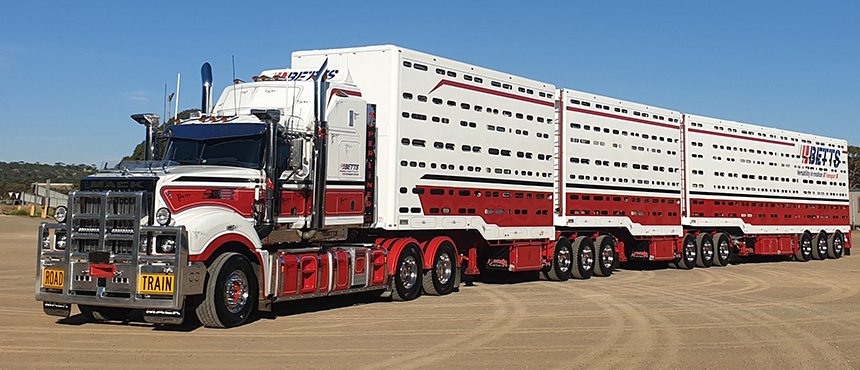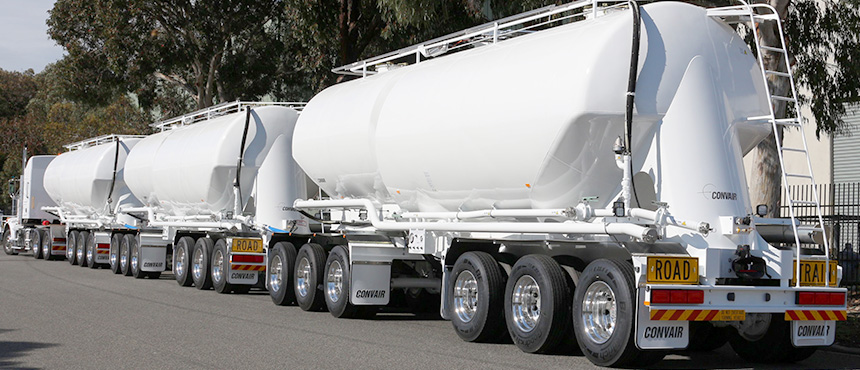Raising the roof: How to load 4.6 metres high and boost productivity
One of the challenges faced when using Performance Based Standards (PBS) is achieving the stability requirements while also meeting the loading height needs. For freight tasks that typically have high centre-of-gravity loads, such as livestock transport or car-carriers, this can prove to be difficult. As a result, operators of these loads typically don’t use PBS, as meeting the standards hinder productivity. But what if there was a way to solve this?

Pictured above: A livestock B-triple road train. Livestock operators typically don’t use PBS as the stability threshold isn’t practical. Photo credit: Arends Trailer
The solution is wide single tyres (WSTs). Also known as super singles, these are tyres with a section width greater than 375 mm.
WSTs significantly improve vehicle stability through two key methods. First, they allow for an increase in ‘effective’ axle track widths by up to 300 mm compared to dual-tyred axles. Second, they provide more internal space on the axle, enabling wider spring centres that enhance the suspension’s roll stiffness. With the right specifications, up to 4.6-metre-high loads are possible.
The added stability also has the potential to dramatically improve high-speed performance, which could make longer combinations more attractive under PBS, such as truck and 2 dogs or A-triples.
So why aren’t they used? Well, Australian adoption of WSTs has been hamstrung by restrictions on axle loads. A recent media release, however, hints that these limitations could soon be removed, allowing WSTs to operate at the same mass as equivalent dual tyred axles. This would unlock enormous productivity gains via PBS. We wrote an article about this last year, which you can find here.
Regardless of the current limitations though, WSTs do still offer untapped potential with PBS.
Take a PBS Level 2 A-double for example. The Heavy Vehicle National Law (HVNL) allows tri-axle groups fitted with WSTs on semi-trailers and dollies up to 21 t at Concessional Mass Limits (CML), which is equivalent to the mass allowed on dual tyres. As a result, Level 2 performing A-doubles with tri-axle dollies, can achieve 85 t GCM at CML. Therefore, car-carrier or livestock 30 m A-double combinations are possible.
An added benefit of WSTs is that they lower the tare mass when compared to duals. As a rough guide, WSTs tend to save around 100 kg in tare mass per axle. For an A-double with a tri-axle dolly, this would equate to 900 kg saving. Consequently, this reduction in tare allows for a 900 kg increase in payload mass, which helps to compensate for the lack of HML accreditation in this scenario.
As a bonus, the National Class 2 PBS Tier 1 and High Productivity Authorisation Notices don’t discriminate on combinations fitted with WSTs, which means that the gazetted networks can be used.
While we have specifically called out livestock and car-carrier operations as industries where productivity gains are on offer, it goes without saying any freight task which requires increased stability, would reap the benefits of WSTs. This could include loggers, tankers, general freight and bulk commodity carriers.
To further optimise stability, there are other design ideas which can be utilised, some of which need PBS for exemptions from the Australian Design Rules (ADRs). Some of these ideas include using drop-decks to lower payload centre-of-gravity, using ballraces instead of fifth wheels, and even replacing pin-couplings with fifth-wheels to ‘roll-couple’ units together. We plan on writing an article about under-utilised innovations available under PBS, so keep an eye on our website.

Pictured above: A PBS 42.5m A-triple. Could the use of WSTs lead to an increase in PBS A-triples? Photo credit: Convair Engineering
If you’re interested in exploring the productivity gains that are possible with PBS, contact Advantia or send me an email at [email protected].
Get more like this in your inbox
Subscribe to our Newsletter and never miss a post.